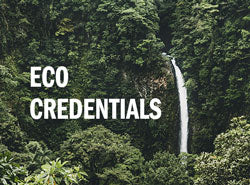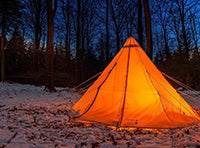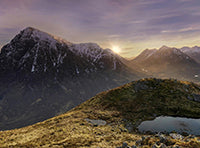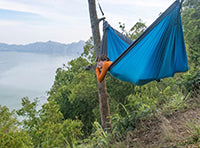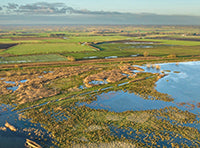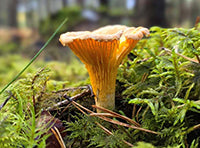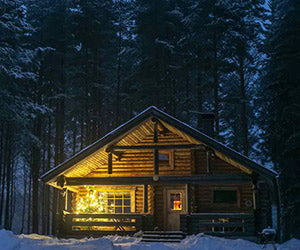Finding the perfect pitch for a wild camp is mostly about planning and preparation. This doesn’t have to be as arduous as it might sound though. Don’t worry, there’s no need to pore over maps for hours on end (though having a passing familiarity with an Ordnance Survey Explorer map certainly helps). On the other hand, unless you get really lucky, there is usually a little more to it than just packing a rucksack, heading out for a walk and then simply stopping when you’ve had enough for the day. And while the first approach may involve a little more work, much of the joy of a truly excellent wild camp is in the planning. Plus, look at it this way – it means you can start enjoying the trip before you even set out!
Generally, travelling by car gives you a bit more flexibility about where you can begin your walk-in and therefore where you can pitch up for the night. However, public transport still offers plenty of scope too. There are often tiny little village train stations that are surrounded by countryside ripe for wild camping. The countryside bus network can also get you to some pretty out-of-the-way places. But it’s worth taking a look at local train or bus timetables so you can plan how much time you’ll have (and therefore how far you can feasibly walk). This will give you a search area radius within striking distance of your start point, to help you identify a walking route with prospective wild camp sites. Don’t forget to make a note of train and bus times for the following day too, so you know where and when you need to get back.
It’s always prudent to check the weather forecast before you head out. A calm settled night is ideal for wild camping. Take a look at the phases of the moon too, since a new moon and clear skies offers the best chance of some epic stargazing.
If you’re planning on heading to upland areas, take a look at the Mountain Weather Information Service (MWIS) forecast. This will give you a good idea of what to expect in terms of rain, wind, visibility and temperature.
The internet has made planning a wild camp so much easier. If you’re a first-time wild camper, Google is your friend. Good wild camp spots are often closely guarded secrets, as people are understandably protective about their favourite locations. Nobody wants the masses descending on their best pitches. But by Googling common search terms and phrases like: ‘best views in…’, ‘highest point in…’, ‘woods in…’, ‘best sunset in…’ or ‘rivers in…’ then you’ll often find some useful starting points.
Another good resource is Instagram. Very few people can resist posting pics of an epic wild camp, so search and save some relevant hashtags (#wildcampinguk, #wildcamp and #wildcamping to name a few) to see what you can find. At the very least you’re likely to find plenty of inspiration. The first step is to identify a likely location that sounds quiet but appealing.
The next step is to check it out on the map to see if it is indeed a valid wild camping option. If you don’t have a paper Ordnance Survey map of the area, a great tip is to use Bing maps and select the (free) OS map layer. This basically gives you access to OS 1:25,000 Explorer mapping without needing to buy a subscription. It also has the advantage that you can switch between the OS map layer and aerial satellite view to glean further information about local terrain and surrounding landscape features.
You don’t need to know how to take a grid reference to be able to find a wild camp spot, but it is useful to understand how terrain is depicted on OS maps. Take a look at the map legend of an OS Explorer map.
As a starting point, look for areas of land depicted on the OS Explorer within an orange border. This indicates open access land, and commonly includes mountains, moors, heath and downland as well as common land. You have a right to walk and run across this land. Though you don’t have the legal right to camp on access land, it frequently takes in wilder and more sparsely-populated parts of the countryside that often make good wild camping spots.
- You’ll want to check your spot isn’t too close to civilisation, like a house or farm. Make sure it isn’t too close to roads, railway lines or popular footpaths and walking or cycling trails either.
- Avoid cultivated orchards and fields that might contain crops or livestock, as well as golf courses and racecourses or working quarries.
- Don’t camp on archaeological or historical sites – these are important and sensitive places, and also attract visitors.
- Don’t camp anywhere within red triangles – sometimes marked ‘DANGER AREA’. This is usually MoD land with managed access, and includes live firing ranges – not a good place to set up a wild camp, for obvious reasons.
- Avoid nature reserves and wildlife areas, especially between 1 March and 31 July, in order to protect ground-nesting birds. Your goal is to enjoy nature, not destroy it, even unwittingly.
- Level, well-drained ground is preferable to anywhere too sloped, boggy or rocky.
- Wooded areas are indicated by little trees in green areas of land. Clearings are shown by blank spaces on the map, surrounded by trees, and these often make good wild camping spots. Non-coniferous woodland is generally preferable to coniferous woodland. The latter is often plantation managed by the Forestry Commission, which is often dark and dense – not so great for wild camping. Logging operations are also often underway. Much better to look for some quiet native woodland.
- Contour lines show changes in elevation – the closer together the lines, the steeper the hill. Look for flat areas where you’ll be able to pitch a tent.
- Green dashed lines are used to indicate public rights of way, like footpaths and bridleways. Green diamonds show a long-distance trail, which might take you through areas where you can often camp a little way off the path.
- Though it isn’t vital, ideally you’ll also want to be fairly close to a water source – either a small lake, stream or spring (marked ‘Spr’ on OS Explorer maps).
Check the aspect of your proposed wild camp site, i.e. which way it faces. If you want to wake up early for an epic sunrise, you’ll need to pitch your tent facing east – but that also means you’ll need a spot with a clear view to the horizon in that direction.
Even if you think you’ve found the perfect wild camping spot, you’ll never know for sure whether it is suitable until you get there. That’s why it is a good idea to identify a few potential options and be flexible, so if you end up having to camp somewhere entirely different to your original plan, you won’t be disappointed. The weather may also play a part – if it’s been raining for days and you’ve chosen a riverside spot, you may find the water is higher than expected. On rainy days, you can’t beat a woodland camp where the tree canopy keeps you drier than if you were out in the open.
If you reach your first spot and are disappointed, don’t despair. Move on to your next location to scope that out. While you’re there, weigh up the pros and cons of your spots – it doesn’t have to be absolutely perfect. If the weather forecast is calm, an exposed site might work, especially if it offers the promise of a great sunrise in the morning. But you won’t sleep if your tent is going to be battered by wind all night, so if the weather is likely to be unsettled, better to seek somewhere with shelter from the elements, even if that means foregoing that stunning view.
Spend five minutes sitting out in your spot to get a good feel for it before you decide whether you want to pitch up or not. What looks like a great spot might turn out to be a popular evening beauty spot, or a regular dog walking route. Ditch your pack and have a quick scout around. Check the ground is fairly level and not too damp. If all seems well and pretty quiet, you’re probably good to go. Wait until the light is fading and then pitch up. Happy camping!

